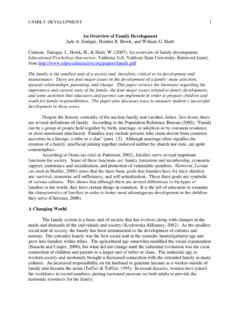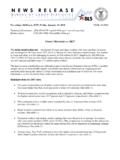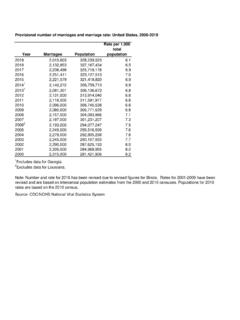Transcription of Optimal taxation in theory and practice 060109 final
1 1 Optimal taxation in theory and practice N. Gregory Mankiw, Matthew Weinzierl, and Danny Yagan N. Gregory Mankiw is Professor of Economics, Matthew Weinzierl is Assistant Professor of Business Administration, and Danny Yagan is a candidate in Economics, all at Harvard University, Cambridge, Massachusetts. Their e-mail addresses are and 2 The Optimal design of a tax system is a topic that has long fascinated economic theorists and flummoxed economic policymakers. This paper explores the interplay between tax theory and tax policy. It identifies key lessons policymakers might take from the academic literature on how taxes ought to be designed, and it discusses the extent to which these lessons are reflected in actual tax policy.
2 We begin with a brief overview of how economists think about Optimal tax policy, based largely on the foundational work of Ramsey (1927) and Mirrlees (1971). We then put forward eight general lessons suggested by Optimal tax theory as it has developed in recent decades: 1) Optimal marginal tax rate schedules depend on the distribution of ability; 2) The Optimal marginal tax schedule could decline at high incomes; 3) A flat tax, with a universal lump-sum transfer, could be close to Optimal ; 4) The Optimal extent of redistribution rises with wage inequality; 5) Taxes should depend on personal characteristics as well as income; 6) Only final goods ought to be taxed, and typically they ought to be taxed uniformly; 7) Capital income ought to be untaxed, at least in expectation.
3 And 8) In stochastic, dynamic economies, Optimal tax policy requires increased sophistication. For each lesson, we discuss its theoretical underpinnings and the extent to which it is consistent with actual tax policy. To preview our conclusions, we find that there has been considerable change in the theory and practice of taxation over the past several decades although the two paths have been far from parallel. Overall, tax policy has moved in the directions suggested by theory along a few dimensions, even though the recommendations of theory along these dimensions are not always definitive. In particular, among OECD countries, top marginal rates have declined, marginal income tax schedules have flattened, and commodity taxes are more uniform and are typically assessed on final goods.
4 However, trends in capital taxation are mixed, and rates still are well above the zero level recommended by theory . Moreover, some of theory s more subtle prescriptions, such as taxes that involve personal characteristics, asset-testing, and history-dependence, remain rare. Where large gaps between theory and policy remain, the harder question is whether policymakers need to learn more from theorists, or the other way around. Both possibilities have historical precedents. The theory of Optimal taxation 3 The standard theory of Optimal taxation posits that a tax system should be chosen to maximize a social welfare function subject to a set of constraints.
5 The literature on Optimal taxation typically treats the social planner as a utilitarian: that is, the social welfare function is based on the utilities of individuals in the society. In its most general analyses, this literature uses a social welfare function that is a nonlinear function of individual utilities. Nonlinearity allows for a social planner who prefers, for example, more equal distributions of utility. However, some studies in this literature assume that the social planner cares solely about average utility, implying a social welfare function that is linear in individual utilities. For our purposes in this essay, these differences are of secondary importance, and one would not go far wrong in thinking of the social planner as a classic linear To simplify the problem facing the social planner, it is often assumed that everyone in society has the same preferences over, say, consumption and leisure.
6 Sometimes this homogeneity assumption is taken one step further by assuming the economy is populated by completely identical individuals. The social planner s goal is to choose the tax system that maximizes the representative consumer s welfare, knowing that the consumer will respond to whatever incentives the tax system provides. In some studies of taxation , assuming a representative consumer may be a useful simplification. However, as we will see, drawing policy conclusions from a model with a representative consumer can also in some cases lead to trouble. After determining an objective function, the next step is to specify the constraints that the social planner faces in setting up a tax system.
7 In a major early contribution, Frank Ramsey (1927) suggested one line of attack: suppose the planner must raise a given amount of tax revenue through taxes on commodities only. Ramsey showed that such taxes should be imposed in inverse proportion to the representative consumer s elasticity of demand for the good, so that commodities which experience inelastic demand are taxed more heavily. Ramsey s efforts have had a profound impact on tax theory as well as other fields such as public goods pricing and 1 Stiglitz (1987) addressed the more restricted agenda of identifying Pareto-efficient taxation , an approach taken up recently by Werning (2007). This approach is important because it suggests that many of the general prescriptions of the Optimal taxation models that use utilitarian social welfare functions survive being recast in Pareto terms, which in turn suggests that the precise form of the social welfare function (at least in the class of all Pareto functions) is not very important for some findings.
8 Despite the more solid normative ground on which this approach rests, it so far has had less influence in the development of tax theory than the utilitarian approach of Mirrlees (1971). 4regulation. However, from the standpoint of the Optimal taxation literature, in which the goal is to derive the best tax system, it is obviously problematic to rule out some conceivable tax systems by assumption. Why not allow the social planner to consider all possible tax schemes, including nonlinear and interdependent taxes on goods, income from various sources, and even non-economic personal characteristics? But if the social planner is allowed to be unconstrained in choosing a tax system, then the problem of Optimal taxation becomes too easy: the Optimal tax is simply a lump-sum tax.
9 After all, if the economy is described by a representative consumer, that consumer is going to pay the entire tax bill of the government in one form or another. Absent any market imperfection such as a preexisting externality, it is best not to distort the choices of that consumer at all. A lump-sum tax accomplishes exactly what the social planner wants. In the world, there are good reasons why lump-sum taxes are rarely used. Most important, this tax falls equally on the rich and poor, placing a greater relative burden on the latter. When Margaret Thatcher, during her time as the Prime Minister of the United Kingdom, successfully pushed through a lump-sum tax levied at the local level (a community charge ) beginning in 1989, the tax was deeply unpopular.
10 As the New York Times reported in 1990, [W]idespread anger over the tax threatens Mrs. Thatcher's political life, if not her physical safety. And it may prove to be the last hurrah for her philosophy of public finance, in which the goals of efficiency and accountability take precedence over the values of the welfare state (Passell, 1990). The tax was quickly revoked, and not coincidentally, Thatcher s term of office ended not long after. As this episode suggests, the social planner has to come to grips with heterogeneity in taxpayers ability to pay. If the planner could observe differences among taxpayers in inherent ability, the planner could again rely on lump-sum taxes, but now those lump-sum taxes would be contingent on ability.

















